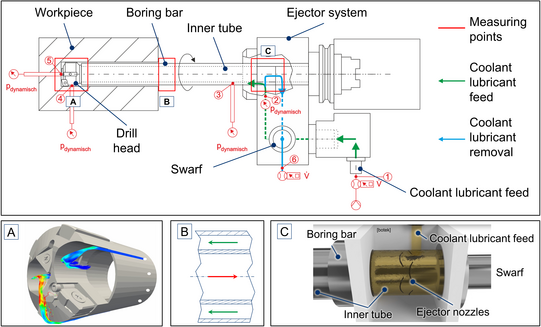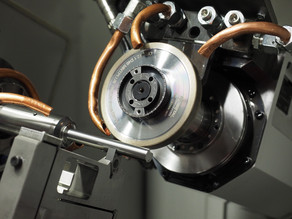Tool and Process Optimization for efficient Ejector Deep-Hole Drilling-Processes using Smoothed Particle Hydrodynamics (SPH)
Ejector deep drilling (also known as double tube system) is one of the three common deep drilling methods and can be used efficiently from a ratio of length to diameter l/D > 3. Characteristic for deep drilling tools is their asymmetry in design and cutting edge arrangement, which results in the need for additional guide elements. In order to realize the advantages of deep hole drilling, such as high cutting performance and high bore quality, also usable on conventional machining centers, the process of ejector deep hole drilling is required. Two concentric boring bars on which the drill head is screwed characterize the design of the tool system. In contrast to other deep drilling methods, no sealing against cooling lubricant and thus no special machine is required. A part of the cooling lubricant flow is diverted directly into the inner tube through ejector nozzles. This process leads to a slight vacuum in the inner tube. Therefore, a reduction of the pressure at the chip collecting opening was created to enable the return flow of the swarf through the main tube (ejector effect).
The current approach in industrial applications is associated with a protracted commissioning of the tool system, which, due to the lack of process knowledge on the ejector effect, is associated with an enormous expenditure of resources. In addition, due to the lack of process knowledge, the required cooling lubricant flow rate is often set higher than necessary during the application, which increases the process costs. This results in the necessity of a detailed analysis of the ejector effect carried out in this project, as this is decisively responsible for a reliable process stability.
In order to achieve this goal, an ejector drilling test rig on the INDEX G250 machining center with adapted sensor technology for process analysis is to be designed and put into operation first. More in-depth investigations are carried out on the test stand in order to gain a physical understanding of the correlations in the development of the ejector effect. In order to realize a physically correct simulation of ejector deep drilling systems with process-typical peculiarities, a simulation model is to be developed in this project with the help of the mesh-free Smoothed Particle Hydrodynamics (SPH) method and validated as well as optimized by the experimental test series. In addition, the test rig will be extended by components of the ejector deep drilling system made of acrylic glass, so that the visualization of the flow using tracer particles for the detailed analysis of the cooling lubricant behaviour and tool wetting is made possible.

The basic understanding gained during this funding period makes it possible to pursue further tool optimization. Flow-optimized tools and double tube systems can be developed and manufactured based on the results. This makes it possible to increase process efficiency and process reliability in ejector deep hole drilling and to shorten the process chain by increasing the usability of the process.




![[Translate to English:] [Translate to English:]](/storages/isf-mb/_processed_/a/1/csm_Wendel_Tiefbohrer_51a08eea1c.jpg)